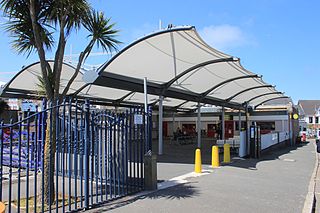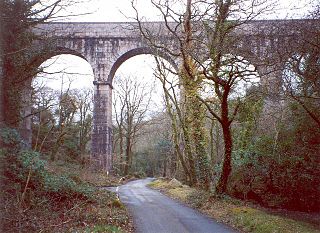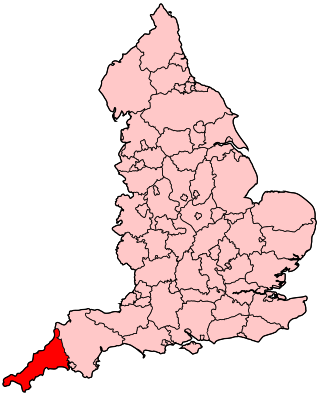
Newquay is a town on the north coast in Cornwall, England, United Kingdom. It is a civil parish, seaside resort, regional centre for aerospace industries with an airport and a spaceport, and a fishing port on the North Atlantic coast of Cornwall, approximately 12 miles (19 km) north of Truro and 20 miles (32 km) west of Bodmin.

Fowey is a port town and civil parish at the mouth of the River Fowey in south Cornwall, England, United Kingdom. The town has been in existence since well before the Norman invasion, with the local church first established some time in the 7th century; the estuary of the River Fowey forms a natural harbour which enabled the town to become an important trading centre. Privateers also made use of the sheltered harbourage. The Lostwithiel and Fowey Railway brought China clay here for export.

Saltash is a town and civil parish in south Cornwall, England. It had a population of 16,184 in 2011 census. Saltash faces the city of Plymouth over the River Tamar and is popularly known as "the Gateway to Cornwall". Saltash’s landmarks include the Tamar Bridge which connects Plymouth to Cornwall by road, and the Royal Albert Bridge. The area of Latchbrook is part of the town.

The Cornish pilot gig is a six-oar rowing boat, clinker-built of Cornish narrow-leaf elm, 32 feet (9.8 m) long with a beam of 4 feet 10 inches (1.47 m). It is recognised as one of the first shore-based lifeboats that went to vessels in distress, with recorded rescues going back as far as the late 17th century. The original purpose of the Cornish pilot gig was as a general work boat, and the craft is used as a pilot boat, taking pilots out to incoming vessels off the Atlantic Coast. At the time pilots would compete between each other for work; the fastest gig crew who got their pilot on board a vessel first would get the job, and hence the payment.

The Lappa Valley Railway is a 15 in minimum gauge railway located near Newquay in Cornwall. The railway functions as a tourist attraction, running from Benny Halt to East Wheal Rose, where there is a leisure area with two miniature railways.

A gig is a type of boat. It was optimised for speed under oar, but usually also fitted with a sailing rig for appropriate conditions. The type was in use by Deal boatmen in the 18th century. It first occurred as a naval ship's boat after Deal boatbuilders recommended a different design to boats ordered from them by the Royal Navy to equip the cutters purchased in the 1760s to combat smuggling. The captains of larger warships soon sought permission to substitute a gig for one of the heavier boats which were then used; some even had a gig built at their own expense. The gig therefore became part of the usual complement of ship's boats used in warships.
Flushing is a coastal village in the civil parish of Mylor, west Cornwall, UK. It is 3 miles (5 km) east of Penryn and 10 miles (16 km) south of Truro. It faces Falmouth across the Penryn River, an arm of the Carrick Roads. The village is known for its yearly Regatta week in July.

The Atlantic Coast Line is a 20+3⁄4-mile (33 km) Network Rail branch line which includes a community railway service in Cornwall, England. The line runs from the English Channel at Par, to the Atlantic Ocean at Newquay.

Par is a village and fishing port with a harbour on the south coast of Cornwall, England, United Kingdom. The village is situated in the civil parish of Tywardreath and Par, although West Par and the docks lie in the parish of St Blaise.

Sport in Cornwall includes two sports not found elsewhere in the world, except in areas influenced by Cornish culture i.e. the Cornish forms of wrestling and hurling. The sports otherwise most closely associated with Cornwall are rugby union football and surfing.

Coastal and offshore rowing is a rowing sport performed at sea. In North America, this sport is often called open water rowing.
The Newquay and Cornwall Junction Railway was a 7 ft broad gauge railway intended to link the Cornwall Railway with the horse-worked Newquay Railway. It opened a short section to Nanpean in 1869, the remainder being built by the Cornwall Minerals Railway who took over the company in 1874. Its main traffic has always been china clay.

Newquay railway station serves the town and seaside resort of Newquay in Cornwall, England. It is the terminus of the Atlantic Coast Line from Par, 302 miles 49 chains from the zero point at London Paddington measured via Box and Plymouth Millbay. The station is situated in the heart of Newquay, close to the town centre itself and the beaches. The station is managed by Great Western Railway which operates local branch line services to and from Par. In the summer, there are also services to and from London.

The Cornwall Minerals Railway owned and operated a network of 45 miles (72 km) of standard gauge railway lines in central Cornwall, England, United Kingdom. It started by taking over an obsolescent horse-operated tramway in 1862, and it improved and extended it, connecting Newquay and Par Harbours, and Fowey. Having expended considerable capital, it was hurt by a collapse in mineral extraction due to a slump in prices. Despite its title, it operated a passenger service between Newquay and Fowey.

The Treffry Tramways were a group of mineral tramways in Cornwall in the United Kingdom, constructed by Joseph Treffry (1782–1850), a local land owner and entrepreneur. They were constructed to give transport facilities to several mines and pits producing non-ferrous metal, granite and china clay in the area between the Luxulyan Valley and Newquay, and were horse-operated, with the use of water and steam power on inclines, and at first operated in conjunction with the Par Canal and Par Docks, also constructed by Treffry. One of the routes crossed the Luxulyan Valley on a large viaduct, the largest in Cornwall when it was built.
The Truro and Newquay Railway was a Great Western Railway line in Cornwall, England, designed to keep the rival London and South Western Railway (LSWR) out of the west of the county. The line was completed in 1905 and closed in 1963.

Fishing in Cornwall, England, UK, has traditionally been one of the main elements of the economy of the county. Pilchard fishing and processing was a thriving industry in Cornwall from around 1750 to around 1880, after which it went into an almost terminal decline. During the 20th century the varieties of fish taken became much more diverse and crustaceans such as crab and lobster are now significant. Much of the catch is exported to France due to the higher prices obtainable there. Though fishing has been significantly damaged by overfishing, the Southwest Handline Fishermen's Association has started to revive the fishing industry. As of 2007, stocks were improving. The Cornwall Sea Fisheries Committee is one of 12 committees responsible for managing the corresponding Sea Fisheries District. The Isles of Scilly Sea Fisheries Committee is responsible for the Scilly district.

Ann Glanville (1796–1880) was a Cornishwoman who achieved national celebrity for rowing a four-oared watermen's boat.

The following outline is provided as an overview of and topical guide to Cornwall: Cornwall – ceremonial county and unitary authority area of England within the United Kingdom. Cornwall is a peninsula bordered to the north and west by the Celtic Sea, to the south by the English Channel, and to the east by the county of Devon, over the River Tamar. Cornwall is also a royal duchy of the United Kingdom. It has an estimated population of half a million and it has its own distinctive history and culture.
Presented below is an alphabetical index of articles related to Cornwall:















